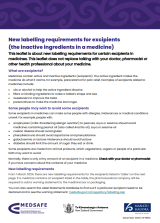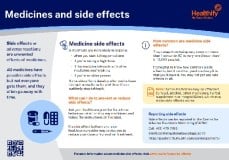Wishing everyone happy holidays and a joyful New Year from the Healthify team. Don't forget to Slip, Slop, Slap and Wrap!
Inactive ingredients in medicines
Also called excipients in medicines
Key points about inactive ingredients in medicines
- Inactive ingredients are extra substances found in medicines such as fillers.
- They're often referred to as excipients.
- Read about inactive ingredients in medicines including why they're added to medicines.

Prescription and over-the-counter (OTC) medicines are made up of many ingredients. The part of the medicine that makes it work is known as the active ingredient, but inactive ingredients or ‘excipients’ are also added.
Different medicines contain different inactive ingredients.
Read more below about how to find out which inactive ingredients are in your medicines.
Inactive ingredients are added to medicines for different reasons, for example:
- To improve the taste – sugar, artificial sweeteners or flavouring may be added to make them taste better.
- To improve the texture – thickening agents may be added to make liquid medicines easier to pour.
- To dissolve the medicine – small amounts of ethanol (alcohol) may be used to help dissolve a liquid into a liquid form.
- To make them easier to handle – powders or fillers can be used to make tablets large enough to handle if the amount of active ingredient is very small.
- To make them work better – extra ingredients may be added to tablets to help them break down properly in your stomach.
- To make them last longer – preservatives might be added to improve the shelf-life of a medicine.
Different medicines contain different inactive ingredients. All medicines approved in Aotearoa New Zealand have been assessed by Medsafe, which includes reviewing the inactive ingredients to ensure they meet their quality and safety standards.
Some people may want to avoid some inactive ingredients. Tell your healthcare provider or pharmacist if you need to avoid any inactive ingredients, as they may be able to provide a different version of the medicine. Note, most medicines have very small amounts of inactive ingredients that are unlikely to cause any problems.
- Peanut oil (also called Arachis): If you're allergic to peanuts, tell your pharmacist so that a different medicine or brand can be provided.
- Soya oil: If you're allergic to peanuts, you may also be allergic to soya. Tell your pharmacist so that a different medicine or brand can be provided.
- Aspartame: This is a sweetener used instead of sugar. People who have phenylketonuria should avoid aspartame because it is converted to phenylalanine in the body.
- Gluten: Most medicines are gluten-free. However, some medicines may contain wheat starch, which people with coeliac disease need to avoid. See gluten in medicines.
- Colourings: Medicines may contain colouring agents that some people are sensitive to. Colour-free forms are available for some medicines.
- Sugar: People with diabetes need to be aware of sugars in medicines. Sugar-free forms may be available.
- Preservatives: Preservatives (eg, parabens – also known as methyl, ethyl or propyl hydroxybenzoates) have been linked to potential allergic reactions. Some preservatives need to be avoided in very young and premature babies, eg, sodium benzoate.
The following inactive ingredients are unlikely to cause any problems but some people may prefer to avoid them.
Lactose
People with some conditions may need to avoid medicines containing lactose. These are rare and include galactose intolerance, total lactose deficiency or glucose-galactose malabsorption. The amount of lactose in tablets is very small, and it's unlikely to have an effect for people who are lactose intolerant.
Alcohol
Some liquid medicines contain a small amount of ethanol (the scientific name for alcohol). Ethanol helps certain ingredients dissolve so the medicine can be made into a liquid form. If a medicine contains 3% ethanol or more, the label must show how much ethanol it has.
Propylene glycol
This is another form of alcohol, now rarely used. If your medicine contains it you should talk to your healthcare provider or pharmacist before giving the medicine to any child under 5 years of age.
Animal-derived ingredients such as gelatin
Some ingredients, such as gelatin, are derived from animal products which vegetarians, vegans and people of particular faith may wish to avoid. Gelatin is sometimes used as the coating of capsules. Lactose is typically from animal milk.
Mannitol and sorbitol
These are artificial sweeteners used in sugar-free forms of medicines. These can cause soft or runny poo (diarrhoea), but as only a small amount is present in medicines, it's unlikely to be a problem.
Note: There may be some information about your medicine that only the pharmaceutical company can provide, such as the source of an ingredient (eg, whether it comes from an animal), ingredients within a flavour or colour and manufacturing impurities or contaminants. This information is specific to the brand of medicine you're taking and can also differ between different strengths of the same brand. If you're concerned about any of the above, talk to your pharmacist about your medicines. Also see below: How to find out which inactive ingredients are in your medicine.
If you would like to know which inactive ingredients are in your medicine, your healthcare provider or pharmacist will be able to help you. You can usually find information about inactive ingredients in the following places.
Medicine boxes or packaging
For medicines released to the Aotearoa New Zealand market from 1 March 2024, there'll be a warning statement on the medicine box or packaging for some inactive ingredients. If the medicine container is small, the warning statement will be on the information leaflet inside the container instead.

Image credit: Medsafe NZ
It's important to note that products that are dietary supplements are covered by a different set of rules. Under the Dietary Supplements Regulations 1985, these products don’t need to be checked by the government before they're sold. Instead, the companies that make them are responsible for making sure their products are safe and follow the law.
Consumer medicine information (CMI)
If there's a consumer leaflet for your medicine, inactive ingredients are listed in the ‘Ingredients’ section near the end of the leaflet. You can also search for the CMI on the Medsafe website(external link).
Data sheet (prescribing information)
The medicine data sheet (prescribing information) lists the inactive ingredients in the ‘Pharmaceutical Particulars’ section near the end of the data sheet. You can search for the data sheet on the Medsafe website(external link).
Product/Application search
If your medicine doesn't have a CMI or a data sheet, you can use Medsafe’s online Product/Application search:(external link)
- Enter the medicine’s brand name in the ‘Trade name’ box. Click on the relevant search result to view the inactive ingredients in that medicine.
- To find out which medicines contain any excipient, enter the inactive ingredients in the ‘Ingredient’ box. The search results list all the medicines containing that inactive ingredient.
Contact the pharmaceutical company
There may be some information about your medicine that only the pharmaceutical company can provide. This may include:
- ingredients within a flavour or colour
- manufacturing impurities or contaminants
- components of an ingredient (eg, caffeine in a natural health product)
- the source of an ingredient (eg, whether it comes from an animal).
Look for the company contact details on the medicine packaging, or at the end of the data sheet, CMI or Product/Application search.
References
- Excipients in medicines(external link) Medsafe, NZ, 2023
- New labelling requirements for excipients (the inactive ingredients in a medicine)(external link) Medsafe, NZ 2023
- Focus on ‘excipients’ in children’s medicines(external link) Medicines for Children, UK
- Pharmaceutical excipients – where do we begin?(external link) Australian Prescriber, 2011
- Soya-based excipients – a problem for people with peanut allergy?(external link) Medsafe, NZ, 2016
Brochures

New labelling requirements for excipients
Medsafe, NZ, 2023

Medicines and side effects
Healthify He Puna Waiora, NZ, 2024

Health Quality and Safety Commission, NZ, 2019
English, Te reo MāoriCredits: Sandra Ponen, Pharmacist, Healthify He Puna Waiora. Healthify is brought to you by Health Navigator Charitable Trust.
Reviewed by: Angela Lambie, Pharmacist, Auckland
Last reviewed:
Page last updated:





